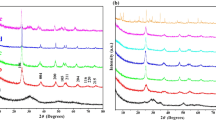Abstract
Ordered mesoporous Fe2O3, TiO2, and Fe2O3–TiO2 composites with different molar Ti to Fe ratio were prepared via a nano-replication method using highly ordered mesoporous silica as a hard template. Physicochemical properties of the mesoporous catalysts were characterized by X-ray diffraction, electron microscopy with energy-dispersive X-ray spectroscopy, and N2 adsorption–desorption analysis. The photocatalytic performances of the catalysts were evaluated in terms of methylene blue removal efficiency, using 70 ppm methylene blue solution with 5 mM H2O2 as an assistive oxidant under UV light and visible light generated by 150 W xenon lamp system. Rate constant values were used to compare photocatalytic activities of the prepared samples. Under UV light, ordered mesoporous TiO2 showed the highest rate constant as expected, and ordered mesoporous Fe2O3–TiO2 (1:1) and (1:2) exhibited comparable catalytic activities to TiO2. In the case of visible light irradiation experiment, the highest rate constant was observed over the catalyst with Fe:Ti molar ratio of 1:1, which is probably due to its low band gap energy (about 1.90 eV). The excellent photocatalytic activity of ordered mesoporous Fe2O3–TiO2 (1:1) under both UV and visible light irradiation can be explained as a consequence of the large surface area with large pore volumes, and charge separation ability enhancement by heterojunctions between Fe2O3 and TiO2.





Similar content being viewed by others
References
Westerhoff P, Yoon Y, Snyder S, Wert E (2005) Fate of endocrine-disruptor, pharmaceutical, and personal care product chemicals during simulated drinking water treatment processes. Environ Sci Technol 39:6649–6663
Kolpin DW, Furlong ET, Meyer MT, Thurman EM, Zaugg SD, Barber LB, Buxton HT (2002) Pharmaceuticals, hormones, and other organic wastewater contaminants in U.S. streams, 1999–2000: a national reconnaissance. Environ Sci Technol 36:1202–1211
Deborde M, Gunten U (2008) Reactions of chlorine with inorganic and organic compounds during water treatment–kinetics and mechanisms: a critical review. Water Res 42:13
Richardson SD, Plewa MJ, Wagner ED, Schoeny R, DeMarini DM (2007) Occurrence, genotoxicity, and carcinogenicity of regulated and emerging disinfection by-products in drinking water: a review and roadmap for research. Mut Res 636:178
Xu P, Zeng GM, Huang DL, Feng CL, Hu S, Zhao MH, Lai C, Wei Z, Huang C, Xie GX, Liu ZF (2012) Use of iron oxide nanomaterials in wastewater treatment: a review. Sci Total Environ 424:1
Litter MI, Navío JA (1996) Photocatalytic properties of iron-doped titania semiconductors. J Photochem Photobiol A 98:171
Morris RD, Audet AM, Angelillo IF, Chalmers TC, Mosteller F (1992) Chlorination, chlorination by-products, and cancer: a meta-analysis. Am J Public Health 82:955–963
Baker KH, Hegarty JP, Redmond B, Reed NA, Herson DS (2002) Effect of oxidizing disinfectants (chlorine, monochloramine, and ozone) on Helicobacter pylori. Appl Environ Microbiol 68:981–984
Koski TA, Stuart LS, Ortenzio LF (1966) Comparison of chlorine, bromine, and iodine as disinfectants for swimming pool water. Appl Microbiol 14:276–279
Akpan UG, Hameed BH (2009) Parameters affecting the photocatalytic degradation of dyes using TiO2-based photocatalysts: a review. J Hazard Mater 170:520–529
Houas A, Lachheb H, Ksibi M, Elaloui E, Cuillard C, Herrmann J (2001) Photocatalytic degradation pathway of methylene blue in water. Appl Catal B 31:145–157
Park SB, Kumarsrinivasan S, Na HJ, Li Z, Choi Y, Yang Y, Kim JM (2015) Facile synthesis of thermally stable mesoporous titania spheres with excellent photocatalytic activitiy. Chem Lett 44:61–63
Mohapatra SK, John SE, Banerjee S, Misra M (2009) Water photooxidation by smooth and ultrathin α-Fe2O3 nanotube arrays. Chem Mater 21:3048–3055
Peng L, Xie T, Lu Y, Fan H, Wang D (2010) Synthesis, photoelectric properties and photocatalytic activity of the Fe2O3/TiO2 heterogeneous photocatalysts. Phys Chem Chem Phys 12:8033–8041
Liu H, Shon HK, Sun X, Vigneswaran S, Nan H (2011) Preparation and characterization of visible light responsive Fe2O3–TiO2 composites. Appl Surf Sci 257:5813–5819
Cong Y, Li Z, Zhang Y, Wang Q, Xu Q (2012) Synthesis of α-Fe2O3/TiO2 nanotube arrays for photoelectron-fenton degradation of phenol. Chem Eng J 191:356–363
Kim T, Kleitz F, Paul B, Ryoo R (2005) MCM-48 like large mesoporous silicas with tailored pore structure: facile synthesis domain in a ternary triblock copolymer-butanol-water system. J Am Chem Soc 127:7601–7610
Shon JK, Kong SS, Kim SS, Kang MS, Kim JM (2008) Synthesis of mesoporous iron oxide nanoparticles from mesoporous silica template via nano-replication. Funct Mater Lett 1:151–154
Kim SS, Lee HI, Shon JK, Hur JY, Kang MS, Park SS, Kong SS, Yu JA, Seo M, Li D, Thakur SS, Kim JM (2008) Preparation of highly ordered mesoporous TiO2 materials with crystalline framework from different mesostructured silica templates via nanoreplication. Chem Lett 37:140–141
Solovyov LA, Zaikovskii VI, Shmakov AN, Belousov OV, Ryoo R (2002) Framework characterization of mesostructured carbon CMK-1 by X-ray powder diffraction and electron microscopy. J Phys Chem B 106:12198–12202
Shon JK, Kong SS, Kim YS, Lee J, Park WK, Park SC, Kim JM (2009) Solvent-free infiltration method for mesoporous SnO2 using mesoporous silica templates. Microporous Mesoporous Mater 120:441–446
Acknowledgements
This work was supported by the cooperative R&D Convergence Program of MSIP (Ministry of Science, ICT and Future Planning) and ISTK (Korea Research Council for Industrial Science and Technology) of Republic of Korea (Grant B551179-12-07-00).
Author information
Authors and Affiliations
Corresponding author
Electronic supplementary material
Below is the link to the electronic supplementary material.
Rights and permissions
About this article
Cite this article
Park, S.B., Li, Z., Park, G.O. et al. Effective Photocatalytic Performance of Ordered Mesoporous Fe2O3–TiO2 Under Visible Light. Top Catal 60, 789–795 (2017). https://doi.org/10.1007/s11244-017-0782-4
Published:
Issue Date:
DOI: https://doi.org/10.1007/s11244-017-0782-4




